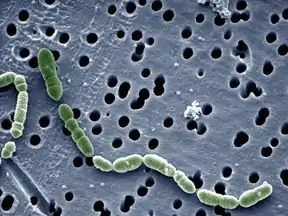Oenococcus oeni
Oenococcus oeni ist ein grampositives Bakterium aus der Ordnung der Milchsäurebakterien (Lactobacillaceae). Dieses Bakterium wurde bis 1995 zur Gattung Leuconostoc gezählt, gilt heute aber neben Oenococcus kitaharae und Oenococcus alcoholitolerans als einziges Mitglied der Gattung Oenococcus. Kennzeichnend für diese Bakterien ist die Milchsäuregärung, ein fermentativer Stoffwechsel, bei dem Milchsäure als Endprodukt auftritt. Oenococcus oeni ist, wie alle Gattungen der Familie Leuconostocaceae, obligat heterofermentativ. Neben Milchsäure treten hierbei auch andere Stoffwechselendprodukte, wie z. B. CO2, Acetat (Essigsäure) und Ethanol (Alkohol) auf, während bei der homofermentativen Milchsäuregärung ausschließlich Milchsäure entsteht. Vom Menschen wird Oenococcus oeni bei der Weinherstellung genutzt.
| Oenococcus oeni | ||||||||||
|---|---|---|---|---|---|---|---|---|---|---|

Oenococcus oeni | ||||||||||
| Systematik | ||||||||||
| ||||||||||
| Wissenschaftlicher Name | ||||||||||
| Oenococcus oeni | ||||||||||
| (Garvie 1967) Dicks et al. 1995 |
Merkmale
Oenococcus oeni ist acidophil, zeigt also gutes Wachstum bei niedrigen pH-Werten. Die Zellen sind kokkenförmig. Oenococcus oeni toleriert große Mengen von Alkohol (Ethanol) und kann in Medien mit 10 % Ethanolanteil kultiviert werden.
Nutzung durch den Menschen
Oenococcus oeni kommt natürlich in Frucht-Maische vor. Dieser Mikroorganismus wird in der Weinproduktion eingesetzt, da er die Fähigkeit besitzt, durch Milchsäuregärung Äpfelsäure in Milchsäure umzuwandeln (Malolaktische Gärung). Dadurch wird der Säuregehalt des Weines verringert, der somit einen milderen Geschmack bekommt.
Bildung von Diacetyl
Oenococcus oeni kann aus Citrat Diacetyl bilden, eine Verbindung mit typischem Buttergeschmack. In geringen Konzentrationen trägt es zum Aroma bei, in größeren Mengen jedoch verdirbt es den Wein.

Systematik und Evolution
Die Gattung Oenococcus bildet zusammen mit Leuconostoc und Weissella die Familie Leuconostocaceae. Diese Gattungen werden innerhalb der Phylogenie zusammen mit weiteren Gattungen wie Lactobacillus, Lactococcus, Enterococcus und Carnobacterium (alle typische Milchsäurebakterien) zu den sogenannten "Clostridium-Zweig" (englisch: Clostridium branch) gestellt, sie sind also evolutionär eng miteinander verwandt. Neben Oenococcus oeni wird seit 2006 die Art Oenococcus kitaharae sowie seit 2015 die Art Oenococcus alcoholitolerans zu der Gattung Oenococcus gestellt.[2] Letztere wurde erstmals 2014 aus Fermentationsbottichen für Cachaça in Brasilien isoliert und ein Jahr später offiziell als neue Spezies innerhalb der Gattung anerkannt[3][4].
Oenococcus oeni steht aufgrund von 16s-rRNA-Untersuchungen im Vergleich zu Arten von Leuconostoc und Weisella weiter entfernt auf dem phylogenetischen Ast und scheint in bei Weissella und Leuconostoc eher konservierten Punkten der rRNA stärker zu variieren. Oenococus oeni scheint somit eine besonders schnelle Evolutionsrate aufzuweisen.[5] Hierbei spricht man von einer tachytelischen Evolutionsrate, der Gegensatz ist die bradytelische Rate, also extrem langsam verlaufende Veränderungen in der Evolution. Allerdings wurde die Annahme einer tachytellischen Evolutionsrate bei Oenococcus oeni wieder in Frage gestellt[6]
Quellen
- E. J. Bartowsky, P. A. Henschke: The 'buttery' attribute of wine--diacetyl--desirability, spoilage and beyond. In: Int. J. Food Microbiol. Band 96, Nr. 3, November 2004, S. 235–52, doi:10.1016/j.ijfoodmicro.2004.05.013, PMID 15454314.
- J. P. Euzéby: List of Prokaryotic names with Standing in Nomenclature (LPSN). Genus Oenococcus (Memento vom 5. Mai 2008 im Internet Archive)
- Fernanda Badotti, Ana Paula B. Moreira, Luciane A. Chimetto Tonon, Brígida T. Luckwu de Lucena, Fátima de Cássia O. Gomes: Oenococcus alcoholitolerans sp. nov., a lactic acid bacteria isolated from cachaça and ethanol fermentation processes. In: Antonie van Leeuwenhoek. Band 106, Nr. 6, 15. Oktober 2014, ISSN 0003-6072, S. 1259–1267, doi:10.1007/s10482-014-0296-z (springer.com [abgerufen am 1. November 2016]).
- Aharon Oren, George M. Garrity: List of new names and new combinations previously effectively, but not validly, published. In: International Journal of Systematic and Evolutionary Microbiology. Band 65, Nr. 4, 1. Januar 2015, S. 1105–1111, doi:10.1099/ijs.0.000178 (microbiologyresearch.org [abgerufen am 1. November 2016]).
- D. Yang, C. R. Woese: Phylogenic structure of the “leuconostocs”: An interesting case of a rapidly evolving organism. In: Syst. Appl. Microbiol. Band 12, 1989, S. 145–149.
- R. Morse, M. D. Collins, K. Ohanlon, S. Wallbanks, P. T. Richardson: Analysis of the beta' subunit of DNA-dependent RNA polymerase does not support the hypothesis inferred from 16S rRNA analysis that Oenococcus oeni (formerly Leuconostoc oenos) is a tachytelic (fast-evolving) bacterium. In: International Journal of Systematic Bacteriology. Band 46, 1996, S. 1004–1009.
Literatur
- J. Björkroth, W. Holzapfel: Genera Leuconostoc, Oenococcus and Weissella. In: M. Dworkin (Hrsg.): The prokaryotes: a handbook on the biology of bacteria: Firmicutes, Cyanobacteria. Vol. 4: Bacteria: Firmicutes, cyanobacteria. 3. Auflage. Springer-Verlag, New York 2006, ISBN 0-387-25494-3, S. 267–319.